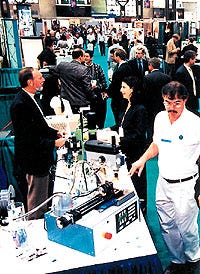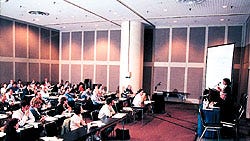July 1, 1999

Wound-Care Products, Plastics for Implants, and Mold-Building Services Introduced at MD&M East

Several companies introduced new products and services at the MD&M East 99 Conference and Exposition in New York City held May 25–27. Attendees were also able to see the products and services displayed by hundreds of exhibitors, as well as attend conference sessions on a variety of topics important to the medical device industry.
Products and Services Highlights
Avery Dennison (Painesville, OH) presented several new products including sterilization-indicator tapes, wound-care products featuring bidirectional stretch, and new formulas of polyurethane and PVC foams. The company noted that 80% of its products are custom made. Victrex (West Chester, PA) announced that it will be supplying PEEK for use in such long-term implants as hip replacements. The material can be processed in standard injection molding machines and doesn't need extensive secondary operations. Jamak Healthcare Technologies (Weatherford, TX) displayed its expertise in the development of silicone technology. The company said that its silicone products offer good formulation and process flexibility, combined with beneficial physical properties and long-term environmental stability. Smart Solutions (Beverly, MA) showed off its new SmarTeam-Works technical data management software. It is designed to give SolidWorks users the tools to create, edit, view, control, and annotate SolidWorks and office-type documents. SolidWorks users will also have the ability to perform advanced searches, maintain revisions in an intuitive manner, and quickly preview documents without actually opening the application that created them. SmarTeam-Works is suitable for desktop and workgroup-level applications, and it provides a direct migration to departmental and enterprise-level users as well.
Conference Highlights
The conference sessions gave attendees an opportunity to listen to experts discuss a variety of topics important to the medical device industry, such as quality systems, FDA submissions, effective design, medical validation, materials, and plastics processing. In the session "Thin-Walled Heat-Shrink Tubing in Medical Device Manufacturing," Mark Saab of Advanced Polymers Inc. (Salem, NH) explained the properties of polyester (PET) heat-shrink tubing, particularly its ability to create ultrathin walls, making it suitable for coating catheters. "PET can increase catheter stiffness two to three times with only a small increase in overall diameter," said Saab. By using different thicknesses of heat-shrink tubing along the length of the catheter, varying degrees of flexibility can be created for improved control of the device. This method eliminates the need for having to join sections of varying thicknesses. High dielectric strength and resistivity make PET a good choice for use as electrical insulation, he said. One application that Saab presented was a needle that was PET-coated along its body. In this way the electrical charge was prevented from touching the skin anywhere but at the tip of the needle.
In a session titled "Risk Analysis and Strategic Design Controls," Geetha Rao, PhD, explained that the goals of design control include establishing efficacy, minimizing safety hazards, complying with quality system regulations, and meeting business goals.

Rao, a managing engineer with Exponent Failure Analysis Associates (Menlo Park, CA), admitted that design control activities can be cumbersome and of questionable value if not well planned. However, she said that starting with a clear definition of the objectives and scope for the analysis can create a document that provides a framework for use throughout the life of a particular device. Failure mode effects analysis (FMEA) is the basis for such analysis. A combination of the usual FMEA brainstorming sessions as well as evaluations of the function and use of the device under normal and abnormal conditions help establish the basic framework of the FMEA. The approach outlined is best suited for devices whose designs are evolving or being modified.
Often, a bottom-up (inductive) approach is taken to establish failure scenarios for FMEAs by identifying initiating events and their relative impacts on safety or business. An example of an initiating event is component failure, which leads to loss of function. A top-down (deductive) approach can also be used to develop fault trees. Here, hazards are identified first, then their potential causes. While top-down approaches are easier to establish and are often recommended by regulatory agencies as a good starting point, Rao says that they are less useful in the long run than FMEAs. Using a top-down approach increases the likelihood that the analysis will be insufficient in scope. This approach also does not account for the probability of any of these events.
Rao suggests using a mixture of top-down and bottom-up approaches, using the generic failure modes as starting points. TÜV Product Service (New Brighton, MN) recommends defining these as "the first point in the causal chain at which the patient is affected." Rao said that a more generalized guideline is defining a failure mode as a potentially adverse experience after the device is handed off, thus potentially involving a physician, surgeon, or hospital, among others.
Although it is impossible to eliminate all unexpected events that can cause product failure, an effective analysis can help minimize their frequency and consequences. The documentation also helps improve the device as each issue is identified and corrected, whether through design, manufacturing, or use.
Business and Acquisition News
Plexus Corp. (Neehah, WI) has opened a new facility in Louisville, CO. The 14,000-sq-ft facility is designed to house up to 60 engineers. It will expand upon the company's engineering services, which include analog, digital, PCB, firmware, and mechanical design. Chemfab Corp. (Merrimack, NH) has introduced its Engineered Elastomer Products Division. It will focus on the design and manufacture of finished products based on high-performance engineered elastomer materials. NuSil Technology (Carpinteria, CA) has created a new subsidiary, NuSil Technology Ltd., with a manufacturing, development laboratory, and technical support facility in Arklow, Ireland. LNP Engineered Plastics (Exton, PA) has announced the completion of a warehouse expansion at its plant in Thorndale, PA. The 23,000-sq-ft expansion enables LNP to provide faster turnaround. Servomex (Norwood, MA) has announced the formation of a new company, Servomex Transducers Ltd., to further develop its gas transducer technology. The new company will design and manufacture the Servomex range of gas transducers, which are marketed to industrial and medical OEMs and are also the key components of the Servomex range of process and environmental gas analyzers. The Plastics Technology Group of NewAge Industries Inc. (Willow Grove, PA) has announced the expansion of its silicone tubing and hose extrusion operation to include platinum-cured products. The facility now produces all of the company's stock silicone products, as well ashandling the various special items that customers request. Prent Corp. (Janesville, WI), a producer of thin-sheet thermoformed products for the medical and electronics industries, has expanded its global operations with new facilities in Malaysia and Costa Rica. The Tech Group Inc. (Scottsdale, AZ) has acquired Vollrath Group Inc. (Sheboygan, WI). Vollrath is a leading supplier of plastic utensils and kit products for the healthcare market. Fluoroware Inc. (Chaska, MN) has announced the European launch of its Cynergy product line. The Cynergy sanitary components are nonmetallic fluid-handling systems capable of withstanding SIP/CIP cycles. Lasertechnics Marking Corp. (Albuquerque) has been acquired by Amphion Capital, a New York City investment capital firm. Lasertechnics provides laser coding systems worldwide. Moll Industries Inc. ( Knoxville, TN), a global supplier of injection-molded plastic components and assemblies, has purchased three U.S. and Canadian facilities from Compression Engineering Inc. Compression Engineering specializes in industrial design, product development, and engineering. Acutek has relocated its European sales office to Brussels, Belgium. Headquartered in Inglewood, CA, Acutek provides pressure-sensitive converting services. Ismeca USA Inc. is moving its North American headquarters to a larger facility located in nearby Vista, CA. The new facility will have the capacity to accommodate additional growth for at least five years by adding 25,000 sq ft. Ciba Specialty Chemicals, Performance Polymers Div., (East Lansing, MI) and Z Corp. (Somerville, MA) have announced an R&D partnership. They will develop new materials for the rapid generation of 3-D models and prototypes. Entela Inc. (Grand Rapids, MI) has acquired Integrity Design and Test Services Inc. (Littleton, MA).Integrity provides product safety and EMC testing to worldwide regulatory standards. Griffith Micro Science (Oak Brook, IL), a provider of sterilization services, has agreed to acquisition by Ion Beam Applications of Belgium. Ion Beam Applications designs and produces particle accelerators for medicine and industry. Creative Imprints Inc. (Norton, MA) has moved to a new, larger facility. The company specializes in providing complex contract printing services with medical-grade inks. Nypro of Puerto Rico has expanded its Technology Center. It now has the latest machinery used for rapid mold making, as well as advanced research and development capabilities. SurModics Inc. (Eden Prairie, MN) has won the 1999 Minnesota Technology Company award from Minnesota Technology Inc. SurModics was chosen due to the market success of its PhotoLink surface-modification technology. Cicoil (Los Angeles) has developed a new manufacturing process for silicon-rubber-encapsulated flat cable. The new method uses a proprietary continuous process that allows flat silicon cables to be produced with virtually any number of conductors in any length.
Copyright ©1999 Medical Product Manufacturing News
You May Also Like


